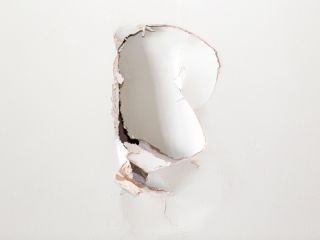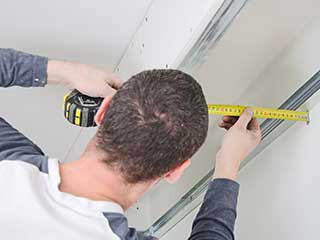Experience top-quality finishes from trusted drywall contractors in combination with Interior Painting.
Crucial Tips for Effective Drywall Repair Work and Setup Methods
Efficient drywall repair service and installation needs a mindful technique. Comprehending the sorts of drywall and having the right devices is crucial. Precise measurements and correct methods can greatly impact the result. Several overlook crucial actions like taping and sanding, which can make or break the final look. As jobs proceed, typical obstacles may develop that require focus. Exploring these ideas can cause an extra sleek and successful surface.
Understanding Different Sorts Of Drywall
Recognizing the different sorts of drywall is important for any effective repair or setup job. Drywall, typically called plaster board, is available in a number of varieties customized for details applications. Requirement drywall is the most commonly made use of kind, ideal for basic indoor wall surfaces and ceilings. Moisture-resistant drywall, typically eco-friendly in color, is created for areas prone to humidity, such as cooking areas and shower rooms. Fireproof drywall, usually colored pink or purple, is crafted to withstand greater temperature levels and is usually utilized in garages or near furnaces. Additionally, soundproof drywall helps in reducing sound transmission, making it ideal for multi-family homes or tape-recording studios. Specialty drywall, like concrete board, is made use of in wet areas like showers or tub borders. Understanding these kinds aids in picking the right product for every project, making sure longevity and efficiency out of commission or brand-new setups.
Necessary Devices for Drywall Repair Work and Installment
Having the right devices is essential for efficient drywall fixing and installation. A high quality energy knife is critical for cutting drywall sheets exactly. A drywall T-square aids ensure straight sides, while a taping knife is needed for using joint substance efficiently over joints. Furthermore, a drywall saw enables reducing out harmed areas or suitable drywall around fixtures.
For hanging drywall, a power drill with drywall screws is crucial, as it allows fast and protected installment. A degree is also vital to validate that the drywall is straight and correctly lined up. A sanding block or pole sander is essential for raveling joint substance once it has dried. Finally, a determining tape is vital for accurate dimensions, avoiding waste and making certain an appropriate fit. Equipped with these tools, people can tackle drywall tasks efficiently, bring about professional-looking results.
Step-by-Step Guide to Repairing Holes and Cracks
When resolving holes and cracks in drywall, having the right tools and products is necessary for a successful fixing. This overview details the necessary items and gives a clear, detailed process to properly bring back the surface area. Comprehending these elements will assist ensure a smooth finish and resilient results.
Tools and Materials Needed
A fully equipped toolkit is essential for reliable drywall repair and installment. Trick tools consist of an energy knife for cutting drywall, a measuring tape to ensure accurate sizing, and a drywall saw for bigger openings. A putty blade is important for applying joint compound efficiently, while a sanding block or post sander assists attain a smooth surface. For patching, a roll of fiberglass mesh tape or paper tape is essential to reinforce joints. In addition, a drill and screws are needed for protecting brand-new drywall items. Important products include joint substance, primer, and paint to complete the repair. Having these devices and materials handy guarantees a smoother, more reliable repair work process, producing professional-looking outcomes.
Fixing Process Actions
Repairing openings and splits in drywall calls for a methodical technique to ensure a smooth surface. First, the area surrounding the damage should be cleaned up thoroughly to remove dust and particles. Next off, for little fractures, a putty blade is used to apply a joint substance equally over the location. For bigger holes, a patch is needed; the damaged section is removed, and a new piece of drywall is suited area, safeguarded with screws. Once the spot is in placement, joint substance is put on blend the edges. After drying out, sanding the area smooth is important. The repaired surface area should be primed and repainted to match the bordering wall surface, making sure a low-profile fixing.
Techniques for Setting Up Drywall Panels
Setting up drywall panels needs careful preparation and accurate implementation to assure a smooth and professional coating. First, it is crucial to measure the wall area precisely and reduce the panels to fit, making certain that they line up with the studs. Positioning the panels flat is usually advised, as this can boost the architectural integrity and lower the variety of joints.
Making use of drywall screws, installers need to secure the panels every 16 inches along the studs, ensuring a firm hold. It is important to stay clear of overdriving the screws, which can damage the paper surface area. For edges and corners, utilizing an energy knife enables for tidy cuts and a snug fit.

Finishing Touches: Insulation, Mudding, and Fining sand
When the drywall panels are safely in position, the next crucial action includes the complements of taping, mudding, and sanding. Taping is vital for producing a smooth shift in between panels and hiding joints. A high quality drywall tape, either paper or fiberglass fit together, must be used over the joints, guaranteeing it sticks appropriately to the mud that will certainly be used following.
Mudding, or applying joint substance, follows the taping process. This substance loads voids and ravel the surface. An initial coat should be applied kindly, feathering the sides to blend with the drywall. After the initial coat dries, subsequent layers may be required for a perfect coating.
Sanding is needed to achieve a smooth surface. A fine-grit sandpaper ought to be used to delicately ravel any blemishes. Treatment must be taken to prevent over-sanding, which can harm the drywall - Drywall Installation Ogden Utah. Correctly carried out, these ending up touches develop a professional look all set for paint
Tips for Keeping Your Drywall After Setup
Preserving drywall after installment is essential to preserving its look and architectural honesty. Routine cleaning is necessary; dirt and dirt can build up, so gentle wiping with a wet cloth is suggested. Property owners ought to also inspect for any type of indicators of dampness or mold and mildew, especially in high-humidity areas like kitchens and restrooms. If any damages occurs, it is essential to resolve it without delay to avoid more check this problems.
Utilizing furniture pads can assist protect against scratches or dents from hefty things. In addition, repainting the drywall with a top quality, cleanable paint supplies an added layer of defense and makes future cleaning much easier. Prevent using rough cleaners or devices, as these can harm the surface area. Finally, maintaining a stable interior climate with ideal humidity degrees will certainly assist avoid breaking or buckling in time. By adhering to these tips, one can assure that drywall continues to be in excellent condition for several years to find.
Frequently Asked Inquiries
Just How Lengthy Does Drywall Require To Totally Dry After Installation?

Can I Set Up Drywall Over Existing Drywall?
Yes, drywall can be mounted over existing drywall, however it redirected here is necessary to ensure the underlying surface area is secure and sufficiently prepared. This technique can improve insulation and decrease installment time, though it might include weight.
What Is the most effective Method to Soundproof Drywall?
The best means to soundproof drywall entails making use of specialized soundproofing products, such as resilient networks, acoustic caulk, and sound-dampening drywall. These strategies efficiently minimize sound transmission in between spaces, enhancing general acoustic efficiency in living rooms.
How Do I Select the Right Drywall Density?
To select the right drywall density, consider the application and location. Requirement residential wall surfaces usually use 1/2 inch, while ceilings or specialized locations may require 5/8 inch for extra strength and soundproofing abilities.
Exist Eco-Friendly Drywall Options Available?
Yes, environment-friendly drywall choices are readily available. These include items made from recycled materials, gypsum boards with low unstable natural compounds (VOCs), and those making use of lasting manufacturing processes, using environmentally-conscious choices for building and construction and improvement jobs.
Having the right devices is necessary for reliable drywall repair service and installment. For hanging drywall, a power drill with drywall screws is essential, as it enables secure and fast setup. Key tools consist of an energy knife for reducing drywall, a tape measure to ensure precise sizing, and a drywall saw for bigger holes. Yes, drywall can be mounted over existing drywall, but it is essential to ensure the underlying surface area is safe and sufficiently prepared. The ideal method to soundproof drywall involves making use of specialized soundproofing materials, such as durable networks, acoustic caulk, and sound-dampening drywall.